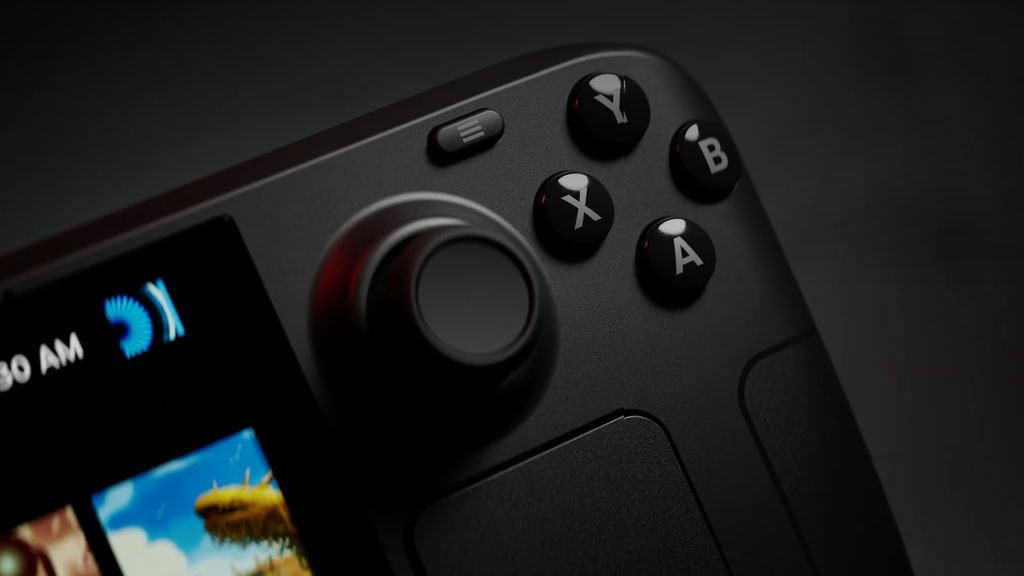Table of Contents
- 1. First checks
- 2. Troubleshooting
- 2.1. Audio issues
- 2.2. Wi-Fi issues
- 2.3. Annoying KDE Wallet popups in desktop mode
- 3. Desktop Mode
- 3.1. Set sudo password
- 3.2. Add nested desktop to gaming mode
- 3.3. Transfer Firefox profile
- 3.4. Remap keyboard
- 3.4.1. Additional tools and tricks
- 3.5. Access serial ports
- 3.6. Crack zip password
- 3.7. LaTeX
- 3.7.1. Install Tex Live
- 3.8. Webdev
- 3.8.1. Podman & distrobox
- 3.8.2. Install NVM (node)
- 3.8.3. Install bun
- 3.9. Add AppImage to start menu using AppImageLauncher
- 3.10. Python
- 3.10.1. Install PIP
- 3.10.2. Install Packages
- 3.11. VSCode / VSCodium
- 4. Decky Loader
- 4.1. Play games from other platform than Steam
- 5. Emulation
- 5.1. Install Emudeck
- 5.2. Nintendo Switch
- 5.2.1. Configure Gyroscope on Yuzu
- 5.3. Resources
First checks
Congratulations, you’ve just received your Steam Deck! Here’s a few things you can check to make sure everything is working as expected:
- Check and apply updates
- Settings
- Controller
- Test Device Input
- Calibration & Advanced Settings
- Reduce deadzones until the joysticks starts registering movements when immobile. Then increase the deadzone by one step.
- Downloads
- Allow download during gameplay
- Controller
- Test for dead pixels
- Go to Desktop mode
- Go to https://lcdtech.info/en/tests/dead.pixel.htm
Troubleshooting
Audio issues
Everytime the Steam Deck is rebooted, the audio stops working because it defaults to a nonexistent “External speakers” instead of the regular “Speakers”.
- Go to Desktop Mode by holding the power button and selecting the option
- Open the System Settings
- In the Hardware section, open the Audio page
- In the Playback Devices find “Rembrandt Radeon High Definition Audio Controller”
- By default, its “Profile” should be set to Pro Audio. Change it Off
- Restart the device
Wi-Fi issues
The Steam Deck keeps losing connectivity. I’m getting the following error: Steam servers can’t be reached.
This is likely to be an compatibility issue between the Steam Deck and particular Wi-Fi access points/brands or particular wifi network configurations. Follow these steps to fix it:
- Start the device in gaming mode and open the Settings
- In the System tab, turn on Developer Mode
- Navigate to the Developer tab and disable “Enable WiFi Power Management”
- Restart the device after making these changes
Annoying KDE Wallet popups in desktop mode
Edit /home/deck/.config/kwalletrc
Add Enabled=false at the end of the file
Desktop Mode
Set sudo password
Go to settings / users / select user and change password
Add nested desktop to gaming mode
Right click on /usr/share/applications/steam/steamos-nested-desktop/steamos-nested-desktop.desktop and press add to steam
Transfer Firefox profile
Transfer profile folder and profiles.ini file to /home/deck/.var/app/org.mozilla.firefox/.mozilla/firefox/
If you want to see the list of profiles, run flatpak run org.mozilla.firefox -P
Remap keyboard
Using X11 XKB, start by dumping the current keyboard layout using this command
xkbcomp $DISPLAY my_keyboard.xkbAfter modification, reapply using:
xkbcomp my_keyboard.xkb $DISPLAYAdditional tools and tricks
Display currently pressed key codes using:
sudo showkeyAccess serial ports
I’m testing serial port through
flatpak install org.thonny.ThonnyAdd yourself to the uucp group
sudo usermod -a -G uucp deckCrack zip password
distrobox enter debiansudo apt install libssl-devgit clone https://github.com/openwall/john --depth 1 --single-branch
cd john/src/
./configure
make -s clean && make -sj4cd ../run/
./zip2john test.zip > hash.txt./john --format=zip --incremental hash.txtLaTeX
Install Tex Live
Download the installer from https://mirror.ctan.org/systems/texlive/tlnet/install-tl-unx.tar.gz Extract the file and run the installer in the terminal
./install-tlPress D to change the installation directory to /home/deck/.local/share/texlive/2025
Press I to install the packages
Webdev
Podman & distrobox
Since SteamOS version 3.5, the deck comes with podman and distrobox preinstalled. This makes installing apps, tools, and library in a sudoless/immutable OS feasible. This also enables you to use various package managers such as apt (Debian/Ubuntu), pacman (Arch), yum (Fedora).
Read more about Toolbox https://containertoolbx.org/
View full list of compatible container distro here https://github.com/89luca89/distrobox/blob/main/docs/compatibility.md#containers-distros
Install NVM (node)
curl -o- https://raw.githubusercontent.com/nvm-sh/nvm/v0.39.7/install.sh | bashInstall bun
curl -fsSL https://bun.sh/install | bashAdd AppImage to start menu using AppImageLauncher
chmod +x appimagelauncher-lite-2.2.0-travis995-0f91801-x86_64.AppImage
./appimagelauncher-lite-2.2.0-travis995-0f91801-x86_64.AppImage installPython
Install PIP
python -m ensurepip --upgrade
echo 'PATH="$HOME/.local/bin:$PATH"' >> ~/.bashrc
PATH="$HOME/.local/bin:$PATH"Install Packages
In your dev repository
-
First, create the virtual environment with:
python3 -m venv venv -
Source the activate file inside the bin directory using the source command:
source venv/bin/activate
VSCode / VSCodium
Set window.titleBarStyle to custom
Decky Loader
https://github.com/SteamDeckHomebrew/decky-loader
Play games from other platform than Steam
- https://github.com/moraroy/NonSteamLaunchers-On-Steam-Deck
- Heroic game launcher
Emulation
Install Emudeck
- Download the Emudeck image for SteamOS https://www.emudeck.com/EmuDeck.desktop
Nintendo Switch
Get firmware at https://prodkeys.net/yuzu-firmware/
Get prod.key at https://prodkeys.net/yuzu-prod-keys/
Configure Gyroscope on Yuzu
- Install gyroscope in Emudeck
- Restart Steam deck
- In desktop mode, open Yuzu
- Open yuzu config, controls, motion
- Hit Test
- Close window and press Motion 1
- Give the device a little check
- Enjoy
Resources
https://emudeck.github.io/cheat-sheet/
https://romsfun.com
https://nopaystation.com/browse
Next Post
Recipe for 36 mini-Canelés
Previous Post
Last post!
